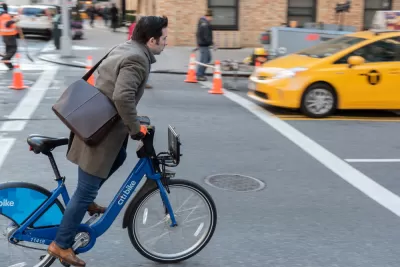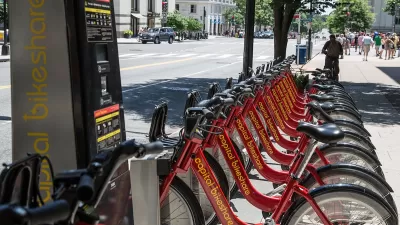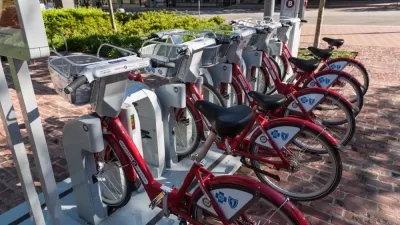The inherent simplicity of bikes makes shared mobility systems a crucial transportation option during natural disasters.

Writing for Bloomberg CityLab, John Surico praises the value of municipal bikeshare systems, which can provide a transportation lifeline during natural disasters or other crises. When Hurricane Ida flooded New York City’s subway system, Surico—and tens of thousands of other New Yorkers—turned to the Citi Bike bikeshare system to get around.
“The nation’s largest bikeshare system clocked 126,360 trips the day after Ida — then the highest in its eight-year history — as bike lanes swarmed with stranded passengers like me,” Surico writes, noting that this held true in other situations.
Citi Bike also broke records this summer during a brutal heat wave that kept subway stations sweltering. When Tube workers went on strike in London in June, Santander Cycles, the city’s bikeshare system, saw riders flocking to it. In Washington, D.C., the Metro’s 2016 repairs led to a 6% increase in ridership for Capital Bikeshare (or CaBi, for short).
The relative simplicity of bikes and bikeshare, Surico writes, “can be particularly useful when other modes are sidelined.” This is why Surico argues that city officials and transit agencies should pay more attention to bikes and the needs of bike users and work to make bikeshare and transit systems complement and support each other.
Jascha Franklin-Hodge, the chief of streets for Boston, noted that the city’s Bluebike bikeshare system was a key alternative for Bostonians when the Orange Line shut down for repairs in August. The city made the system free during the shutdown to ease the transition for commuters. “If you don’t think of bikes as transportation, you will not do the things you need to do to make it a good alternative during a transportation crisis,” Franklin-Hodge said.
FULL STORY: In Times of Crisis, Bikeshare Rolls On

Planetizen Federal Action Tracker
A weekly monitor of how Trump’s orders and actions are impacting planners and planning in America.

Maui's Vacation Rental Debate Turns Ugly
Verbal attacks, misinformation campaigns and fistfights plague a high-stakes debate to convert thousands of vacation rentals into long-term housing.

San Francisco Suspends Traffic Calming Amidst Record Deaths
Citing “a challenging fiscal landscape,” the city will cease the program on the heels of 42 traffic deaths, including 24 pedestrians.

Amtrak Rolls Out New Orleans to Alabama “Mardi Gras” Train
The new service will operate morning and evening departures between Mobile and New Orleans.

The Subversive Car-Free Guide to Trump's Great American Road Trip
Car-free ways to access Chicagoland’s best tourist attractions.

San Antonio and Austin are Fusing Into one Massive Megaregion
The region spanning the two central Texas cities is growing fast, posing challenges for local infrastructure and water supplies.
Urban Design for Planners 1: Software Tools
This six-course series explores essential urban design concepts using open source software and equips planners with the tools they need to participate fully in the urban design process.
Planning for Universal Design
Learn the tools for implementing Universal Design in planning regulations.
Heyer Gruel & Associates PA
JM Goldson LLC
Custer County Colorado
City of Camden Redevelopment Agency
City of Astoria
Transportation Research & Education Center (TREC) at Portland State University
Jefferson Parish Government
Camden Redevelopment Agency
City of Claremont





























